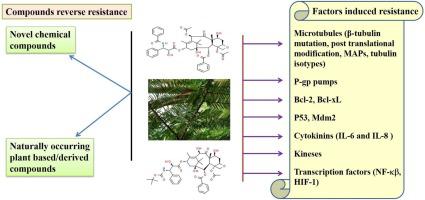Drug Resistance Updates ( IF 15.8 ) Pub Date : 2021-02-27 , DOI: 10.1016/j.drup.2021.100754 Tuyelee Das 1 , Uttpal Anand 2 , Swaroop Kumar Pandey 2 , Charles R Ashby 3 , Yehuda G Assaraf 4 , Zhe-Sheng Chen 3 , Abhijit Dey 1

|
One of the primary causes of attenuated or loss of efficacy of cancer chemotherapy is the emergence of multidrug resistance (MDR). Numerous studies have been published regarding potential approaches to reverse resistance to taxanes, including paclitaxel (PTX) and docetaxel, which represent one of the most important classes of anticancer drugs. Since 1984, following the FDA approval of paclitaxel for the treatment of advanced ovarian carcinoma, taxanes have been extensively used as drugs that target tumor microtubules. Taxanes, have been shown to affect an array of oncogenic signaling pathways and have potent cytotoxic efficacy. However, the clinical success of these drugs has been restricted by the emergence of cancer cell resistance, primarily caused by the overexpression of MDR efflux transporters or by microtubule alterations. In vitro and in vivo studies indicate that the mechanisms underlying the resistance to PTX and docetaxel are primarily due to alterations in α-tubulin and β-tubulin. Moreover, resistance to PTX and docetaxel results from: 1) alterations in microtubule-protein interactions, including microtubule-associated protein 4, stathmin, centriole, cilia, spindle-associated protein, and kinesins; 2) alterations in the expression and activity of multidrug efflux transporters of the ABC superfamily including P-glycoprotein (P-gp/ABCB1); 3) overexpression of anti-apoptotic proteins or inhibition of apoptotic proteins and tumor-suppressor proteins, as well as 4) modulation of signal transduction pathways associated with the activity of several cytokines, chemokines and transcription factors.
In this review, we discuss the abovementioned molecular mechanisms and their role in mediating cancer chemoresistance to PTX and docetaxel. We provide a detailed analysis of both in vitro and in vivo experimental data and describe the application of these findings to therapeutic practice. The current review also discusses the efficacy of different pharmacological modulations to achieve reversal of PTX resistance. The therapeutic roles of several novel compounds, as well as herbal formulations, are also discussed. Among them, many structural derivatives had efficacy against the MDR phenotype by either suppressing MDR or increasing the cytotoxic efficacy compared to the parental drugs, or both. Natural products functioning as MDR chemosensitizers offer novel treatment strategies in patients with chemoresistant cancers by attenuating MDR and increasing chemotherapy efficacy. We broadly discuss the roles of inhibitors of P-gp and other efflux pumps, in the reversal of PTX and docetaxel resistance in cancer cells and the significance of using a nanomedicine delivery system in this context. Thus, a better understanding of the molecular mechanisms mediating the reversal of drug resistance, combined with drug efficacy and the application of target-based inhibition or specific drug delivery, could signal a new era in modern medicine that would limit the pathological consequences of MDR in cancer patients.
中文翻译:

克服癌症中紫杉烷耐药性的治疗策略
癌症化疗疗效减弱或丧失的主要原因之一是多药耐药性 (MDR) 的出现。已经发表了大量关于逆转紫杉烷类药物耐药性的潜在方法的研究,包括紫杉醇 (PTX) 和多西他赛,它们代表了最重要的抗癌药物类别之一。自 1984 年以来,随着 FDA 批准紫杉醇治疗晚期卵巢癌,紫杉烷类已被广泛用作靶向肿瘤微管的药物。紫杉烷已被证明会影响一系列致癌信号通路并具有强大的细胞毒性功效。然而,这些药物的临床成功受到癌细胞耐药性出现的限制,这主要是由 MDR 外排转运蛋白的过表达或微管改变引起的。一世体外和体内研究表明,对 PTX 和多西紫杉醇产生耐药性的机制主要是由于 α-微管蛋白和 β-微管蛋白的改变。此外,对 PTX 和多西紫杉醇的耐药性源于:1) 微管-蛋白质相互作用的改变,包括微管相关蛋白 4、stathmin、中心粒、纤毛、纺锤体相关蛋白和驱动蛋白;2) ABC 超家族多药外排转运蛋白的表达和活性的改变,包括 P-糖蛋白 (P-gp/ABCB1);3) 抗凋亡蛋白的过表达或凋亡蛋白和肿瘤抑制蛋白的抑制,以及 4) 与几种细胞因子、趋化因子和转录因子的活性相关的信号转导途径的调节。
在这篇综述中,我们讨论了上述分子机制及其在介导癌症对 PTX 和多西他赛耐药中的作用。我们提供了体外和体内的详细分析实验数据并描述这些发现在治疗实践中的应用。本综述还讨论了不同药理调节对逆转 PTX 耐药性的功效。还讨论了几种新化合物以及草药制剂的治疗作用。其中,与母体药物相比,许多结构衍生物通过抑制 MDR 或增加细胞毒性功效,或两者兼而有之,对 MDR 表型具有功效。作为 MDR 化学增敏剂的天然产物通过减弱 MDR 和提高化疗疗效,为患有化学耐药性癌症的患者提供了新的治疗策略。我们广泛讨论了 P-gp 和其他外排泵抑制剂的作用,在逆转癌细胞中的 PTX 和多西紫杉醇耐药性以及在这种情况下使用纳米药物递送系统的意义。因此,更好地理解介导耐药性逆转的分子机制,结合药物疗效和基于靶点的抑制或特异性药物递送的应用,可能预示着现代医学的新时代,这将限制 MDR 的病理后果癌症患者。









































 京公网安备 11010802027423号
京公网安备 11010802027423号